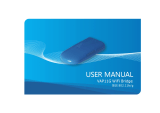
12
Chapter 4: Setting up and Connecting the USB Adapter
Setting Up the Adapter
Compact Wireless-G USB Adapter
Setting Up the Adapter with Available Networks
If you’re not setting up the Adapter with SecureEasySetup, another method for setting up the Adapter is with the
available networks listed on the Available Wireless Network screen. The available networks are listed in the table
on the center of the screen by SSID. Select the wireless network you wish to connect to and click the Connect
button. (If you do not see your network listed, you can click the Refresh button to bring the list up again.) If the
network utilizes wireless security, you will need to configure security on the Adapter. If not, you will be taken
directly to the Congratulations screen.
1. If wireless security has been enabled on this network, you will see a wireless security screen. If your network
utilizes WEP (Wired Equivalent Privacy) encryption, the WEP Key Needed for Connection screen will appear. If
your network utilizes WPA-Personal (Wi-Fi Protected Access) encryption, the WPA-Personal Needed for
Connection screen will appear. If your network utilizes PSK2 (Pre-Shared Key 2) encryption, the PSK2 Needed
for Connection screen will appear.
WEP Key Needed for Connection
Select 64-bit or 128-bit.
Then, enter a passphrase or WEP key.
Passphrase - Enter a passphrase in the Passphrase field, so a WEP key is automatically generated. The
passphrase is case-sensitive and should not be longer than 16 alphanumeric characters. It must match the
passphrase of your other wireless network devices and is compatible with Linksys wireless products only. (If
you have any non-Linksys wireless products, enter the WEP key manually on those products.)
WEP Key - The WEP key you enter must match the WEP key of your wireless network. For 64-bit encryption,
enter exactly 10 hexadecimal characters. For 128-bit encryption, enter exactly 26 hexadecimal characters.
Valid hexadecimal characters are “0” to “9” and “A” to “F”.
Then, click Connect and proceed to the Congratulations screen. To cancel the connection, click Cancel.
Figure 4-9: Available Wireless Network
Figure 4-10: WEP Key Needed for Connection
wep (wired equivalent privacy): a method of encrypting network
data transmitted on a wireless network for greater security.
encryption: encoding data transmitted in a network.




















